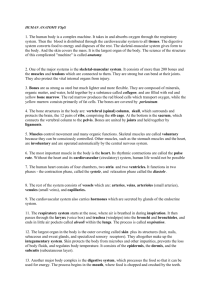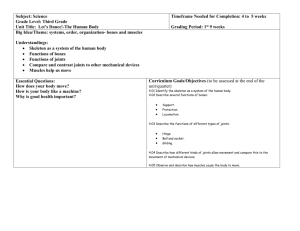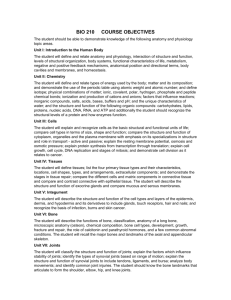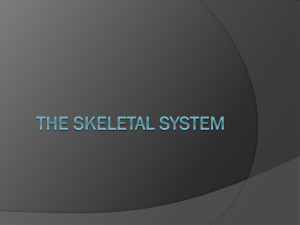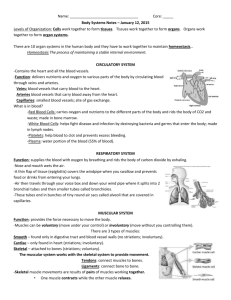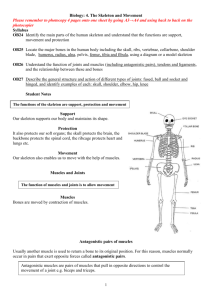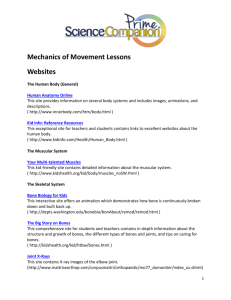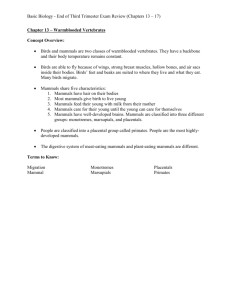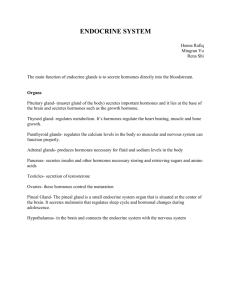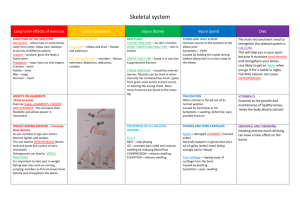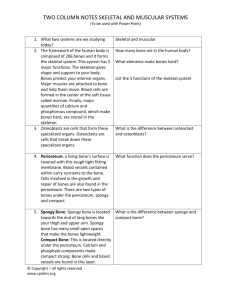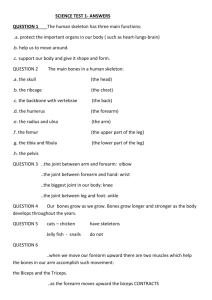HUMAN ANATOMY FSpS
advertisement
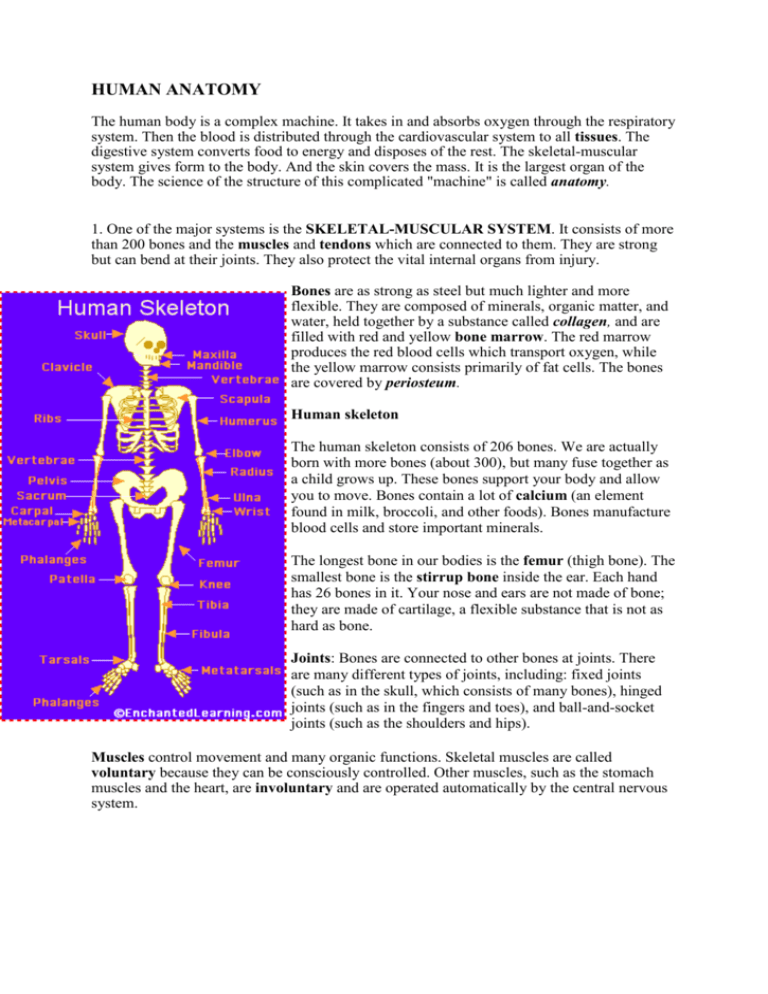
HUMAN ANATOMY The human body is a complex machine. It takes in and absorbs oxygen through the respiratory system. Then the blood is distributed through the cardiovascular system to all tissues. The digestive system converts food to energy and disposes of the rest. The skeletal-muscular system gives form to the body. And the skin covers the mass. It is the largest organ of the body. The science of the structure of this complicated "machine" is called anatomy. 1. One of the major systems is the SKELETAL-MUSCULAR SYSTEM. It consists of more than 200 bones and the muscles and tendons which are connected to them. They are strong but can bend at their joints. They also protect the vital internal organs from injury. Bones are as strong as steel but much lighter and more flexible. They are composed of minerals, organic matter, and water, held together by a substance called collagen, and are filled with red and yellow bone marrow. The red marrow produces the red blood cells which transport oxygen, while the yellow marrow consists primarily of fat cells. The bones are covered by periosteum. Human skeleton The human skeleton consists of 206 bones. We are actually born with more bones (about 300), but many fuse together as a child grows up. These bones support your body and allow you to move. Bones contain a lot of calcium (an element found in milk, broccoli, and other foods). Bones manufacture blood cells and store important minerals. The longest bone in our bodies is the femur (thigh bone). The smallest bone is the stirrup bone inside the ear. Each hand has 26 bones in it. Your nose and ears are not made of bone; they are made of cartilage, a flexible substance that is not as hard as bone. Joints: Bones are connected to other bones at joints. There are many different types of joints, including: fixed joints (such as in the skull, which consists of many bones), hinged joints (such as in the fingers and toes), and ball-and-socket joints (such as the shoulders and hips). Muscles control movement and many organic functions. Skeletal muscles are called voluntary because they can be consciously controlled. Other muscles, such as the stomach muscles and the heart, are involuntary and are operated automatically by the central nervous system. 2. The most important muscle in the body is the heart. Its rhythmic contractions are called the pulse rate. Without the heart and its CARDIOVASCULAR (circulatory) SYSTEM, human life would not be possible The human heart consists of four chambers, two atria and two ventricles. It functions in two phases - the contraction phase, called the systole, and relaxation phase called the diastole . The rest of the system consists of vessels which are: arteries, veins, arterioles (small arteries), venules (small veins), and capillaries. 3. The cardiovascular system also carries hormones which are secreted by glands of the ENDOCRINE SYSTEM. 4. The RESPIRATORY SYSTEM starts at the nose, where air is breathed in during inspiration. It then passes through the larynx (voice box) and trachea (windpipe) into the bronchi and bronchioles, and ends in little air pockets called alveoli within the lungs. The process is called respiration. 5. The largest organ in the body is the outer covering called skin plus its structures (hair, nails, sebaceous and sweat glands, and specialized sensory receptors). They altogether make up the INTEGUMENTARY SYSTEM. Skin protects the body from microbes and other impurities, prevents the loss of body fluids, and regulates body temperature. It consists of the epidermis, the dermis, and the subcutis (subcutaneous layer). 6. Another major body complex is the DIGESTIVE SYSTEM, which processes the food so that it can be used for energy. The process begins in the mouth, where food is chopped and crushed by the teeth. The food then passes through the esophagus in the stomach. From there the food passes into small intestine, where it is absorbed. 7. What cannot be absorbed is passed out through the large intestine as feces. Liquid wastes are eliminated through the URINARY SYSTEM. They are picked up by the blood and removed by the kidneys. From there they pass through the ureter, bladder, a urethra, and are excreted from the body as urine. 8. Closely associated with the urinary system is the REPRODUCTIVE SYSTEM, by which human life is carried on to future generations. The basic male reproductive system consists of two testicles, producing sperms, the penis and the prostate. The female reproductive system contains three main parts: the vagina, the uterus, two ovaries, which produce the ova. 9. The NERVOUS SYSTEM controls all other systems and bodily movements. The nervous system is divided into the central nervous system (the brain and spinal cord) and the peripheral nervous system, which consists of the nerves that connect muscles and sensory organs with the central nervous system. The brain is not only the most important component of the nervous system; it is also the controller of all bodily activities, thoughts, and emotions. English terms denoting parts of the human body: ankle arm navel chest chin ear elbow eye fingers foot hand head heel hip knee leg mouth nose neck shin shoulder thigh toes waist wrist Label the human body diagram using the word list above. Human anatomy – short quiz 1. What is the largest organ of the body? 2. What is the main function of the skeletal-muscular system? 3. What is the most important muscle in the body and why? 4. How many pairs of ribs are there in the human body? 5. How are blood vessels divided? 6. Describe the passages of the respiratory system. 7. Name the structures of skin. 8. What are the main layers composing the skin? 9. What are the main parts of the digestive system? 10. Where do the liquid wastes pass from the kidneys? 11. How is the nervous system divided? 12. How are muscles divided? What do you think??? Do women have the same number of ribs as men? Are there any differences between the skeleton of male and female? Do the male muscles have the same proportion of weight as female muscles?

